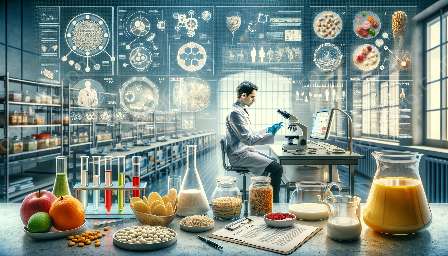Food additives play a crucial role in modern food production, enhancing flavor, texture, and shelf-life. However, ensuring the safety and proper usage of these additives is a significant concern for the food industry and regulatory authorities. The study of food additives encompasses various techniques and methods for detecting and identifying these substances. This topic cluster aims to highlight the diverse methods involved in the analysis of food additives, and their compatibility with the broader field of food and drink.
Understanding Food Additives
Before delving into the methods of detecting and identifying food additives, it is important to understand what food additives are and why their analysis is essential. Food additives are substances added to food products to preserve flavor or enhance taste, appearance, or other qualities. These may include artificial or natural ingredients such as preservatives, colorants, flavors, sweeteners, and more. While many additives are harmless, others may have potential health risks if consumed in excessive amounts.
The use of food additives is regulated in most countries to ensure that they are safe for consumption. However, due to the wide range of additives and their potential impact on public health, it is crucial to have effective methods for detecting and identifying these substances in food products.
Methods of Detection and Identification
Several analytical techniques are employed to detect and identify food additives in various food products. These methods often involve sophisticated laboratory equipment and scientific expertise. Some of the primary methods used for this purpose include:
- Chromatography: Chromatographic techniques, such as gas chromatography (GC) and high-performance liquid chromatography (HPLC), are widely used for separating and analyzing complex mixtures of food additives. These techniques are valuable for identifying specific additives and determining their concentrations in food samples.
- Spectrometry: Spectrometric methods, including mass spectrometry and atomic absorption spectroscopy, are instrumental in detecting and quantifying food additives based on their unique spectral properties. Spectrometry enables precise identification of additives at the molecular level, even in trace amounts.
- Immunological Methods: Immunoassays, such as enzyme-linked immunosorbent assay (ELISA), utilize specific antibodies to detect and quantify food additives. These methods are particularly effective for screening large numbers of samples quickly and accurately.
Advanced Techniques in Additive Analysis
While traditional methods like chromatography and spectrometry remain essential, advancements in technology have led to the development of more sophisticated techniques for analyzing food additives:
- DNA-Based Techniques: DNA barcoding and sequencing have emerged as innovative tools for identifying food additives, especially in complex mixtures where traditional methods may fall short. These techniques rely on the unique genetic signatures of food additives, offering unparalleled accuracy in their identification.
- Nanotechnology: Nanosensors and nanomaterials are being explored for their potential in detecting and quantifying food additives with exceptional sensitivity and specificity. Nanotechnology holds promise for revolutionizing the field of additive analysis with its miniaturized and highly sensitive detection platforms.
Relevance to the Study of Food Additives
The methods of detecting and identifying food additives hold immense significance in the broader study of food additives. Researchers and food scientists rely on these analytical techniques to ensure compliance with food safety regulations, assess the quality of processed food, and investigate potential adulteration. Understanding these methods is essential for students and professionals in the food science and technology field, as it enables them to make informed decisions regarding the use and monitoring of food additives.
Integration with Food & Drink Industry
The study of food additives and their analytical methods aligns closely with the food and drink industry, where the safety and quality of food products are of utmost importance. Manufacturers, regulatory bodies, and quality control professionals in the food industry utilize advanced analytical methods to verify the presence and permissible levels of food additives, ensuring consumer safety and regulatory compliance.
By integrating the methods of detecting and identifying food additives with the broader landscape of food and drink, this topic cluster serves to illustrate the convergence of scientific analysis and real-world applications within the food industry.

